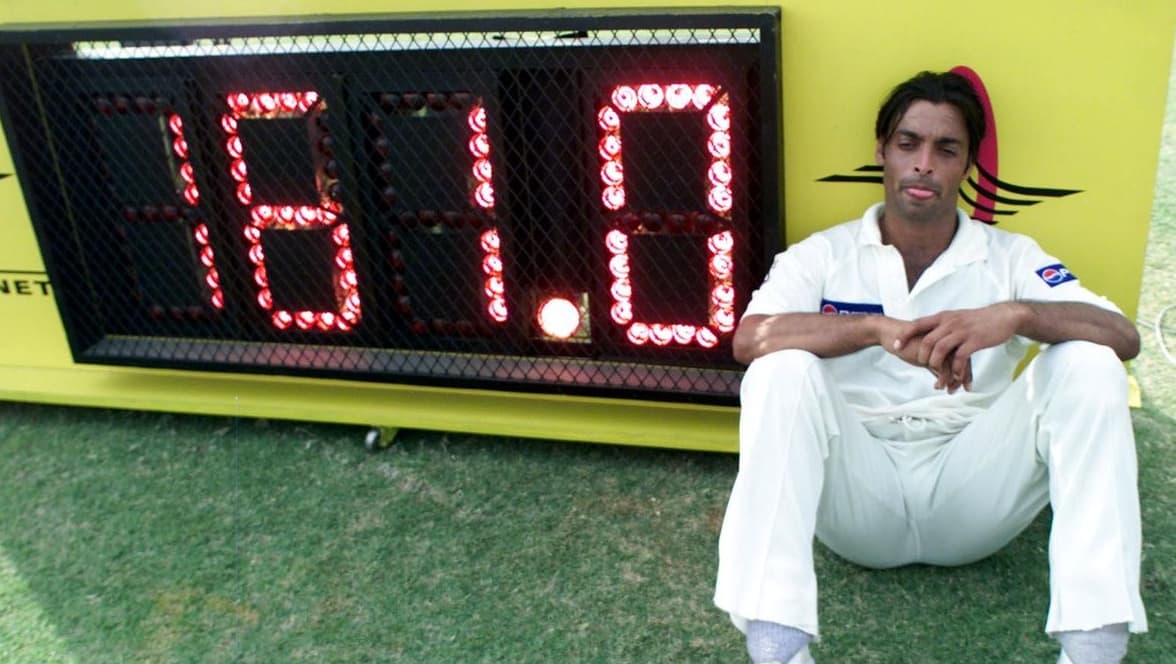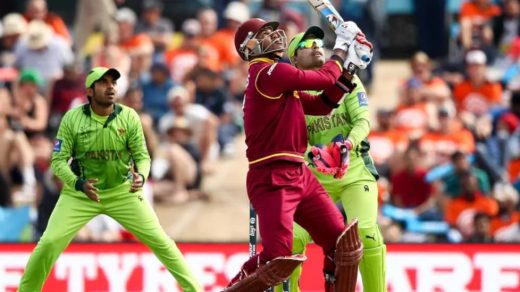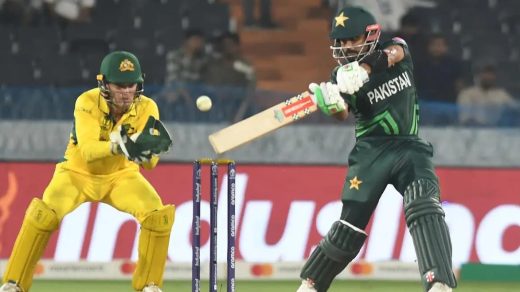There is nothing in cricket quite like watching a genuine fast bowler in full flight.
The long, menacing run-up, the explosive leap at the crease, and the sight of a cricket ball hurtling through the air at speeds approaching 100 mph create moments of pure sporting drama.
For batsmen, facing such deliveries represents cricket’s ultimate challenge—requiring extraordinary courage, lightning-fast reflexes, and impeccable technique.
The fastest bowlers in cricket history form an exclusive brotherhood of athletes who have pushed human physical capabilities to their limits.
These rare individuals combine natural gifts, technical mastery, and fierce determination to generate bowling speeds that most cricketers can only dream of achieving.
Their presence on the field changes the entire dynamic of a match—creating tension, excitement, and the constant possibility of game-changing moments.
World Fastest Bowler Ranking

This comprehensive guide examines the fourteen bowlers who have recorded the highest verified speeds in international cricket.
We’ll explore what made each bowler special, the techniques they used to generate such extreme pace, their career highlights, and their lasting impact on the game.
From the intimidating aggression of the 1970s to the scientific precision of modern cricket, these speed merchants represent the evolution of cricket’s most physically demanding discipline.
The Elite Speed Club: Cricket’s Fastest Recorded Deliveries
| Rank | Bowler | Top Speed | Country | Opponent | Year |
|---|---|---|---|---|---|
| 1 | Shoaib Akhtar | 161.3 km/h (100.23 mph) | Pakistan | England | 2003 |
| 2 | Brett Lee | 161.1 km/h (100.1 mph) | Australia | New Zealand | 2005 |
| 3 | Shaun Tait | 161.1 km/h (100.1 mph) | Australia | England | 2010 |
| 4 | Jeff Thomson | 160.6 km/h (99.8 mph) | Australia | West Indies | 1975 |
| 5 | Mitchell Starc | 160.4 km/h (99.7 mph) | Australia | New Zealand | 2015 |
| 6 | Andy Roberts | 159.5 km/h (99.1 mph) | West Indies | Australia | 1975 |
| 7 | Fidel Edwards | 157.7 km/h (98.0 mph) | West Indies | South Africa | 2003 |
| 8 | Mitchell Johnson | 156.8 km/h (97.4 mph) | Australia | England | 2013 |
| 9 | Mohammad Sami | 156.4 km/h (97.1 mph) | Pakistan | Zimbabwe | 2003 |
| 10 | Shane Bond | 156.4 km/h (97.1 mph) | New Zealand | India | 2003 |
| 11 | Nantie Hayward | 154.4 km/h (95.95 mph) | South Africa | India | 2001 |
| 12 | Jason Gillespie | 153.9 km/h (95.6 mph) | Australia | South Africa | 2002 |
| 13 | Waqar Younis | 153 km/h (95.07 mph) | Pakistan | South Africa | 1993 |
| 14 | Jasprit Bumrah | 153.26 km/h (95.2 mph) | India | Australia | 2018 |
Different Paths to Extreme Pace: Techniques and Approaches
What makes this list particularly fascinating is that these fourteen bowlers achieved similar speeds through remarkably different methods. Let’s examine the principal bowling styles that produce extreme pace:
The Classical Technicians
Brett Lee and Shane Bond represent the purists’ approach to fast bowling—textbook actions that generate extreme pace through technical perfection rather than unorthodox methods.
Lee’s approach featured:
- A smooth, rhythmical run-up building momentum efficiently
- Perfect body alignment at the crease
- High arm action maximizing leverage
- Complete follow-through transferring all energy to the ball
Bond similarly employed biomechanical efficiency:
- Side-on alignment at delivery
- Perfectly braced front leg creating a solid fulcrum
- Clean arm rotation minimizing energy leakage
- Exceptional shoulder rotation speed
These bowlers prove that extreme pace doesn’t require unconventional techniques—when the fundamentals are executed perfectly, speeds exceeding 160 km/h are achievable while maintaining accuracy and control.
The Natural Slingers
Jeff Thomson, Shaun Tait, and Fidel Edwards represent a contrasting approach—slingy, side-arm deliveries that defy coaching manuals but generate frightening velocity.
Thomson’s revolutionary action included:
- A catapult-like release with the arm coming from behind the body
- Minimal front arm involvement
- Natural whipping action rather than conventional rotation
- Maximum wrist snap at release
Tait adopted a similar philosophy:
- A dramatically side-on approach at delivery
- Low arm slot nearly at horizontal
- Explosive final stride generating rotational force
- Powerful wrist action adding final acceleration
These bowlers demonstrate that unconventional doesn’t mean ineffective—their natural actions perfectly suited their physical attributes, allowing them to generate pace that conventional techniques might not have achieved for their body types.
The Power Merchants
Shoaib Akhtar and Mitchell Johnson represent bowlers who combined decent technique with extraordinary physical power and aggression.
Akhtar’s approach centered on:
- An exceptionally long run-up building tremendous momentum
- Explosive leap at the crease converting horizontal energy to vertical
- Open-chested delivery utilizing maximum shoulder rotation
- Hyperextended elbow creating a whip-like effect
Johnson similarly relied on physicality:
- Upper body strength rather than just technique
- Aggressive delivery stride driving through the crease
- Muscular shoulder rotation generating torque
- Intimidating body language complementing physical tools
These bowlers remind us that while technique matters, raw physical power and the willingness to push the body to its limits remain crucial elements in generating extreme pace.
The Modern Innovators
Mitchell Starc and Jasprit Bumrah represent the newest generation of fast bowlers who combine elements of classical technique with biomechanical innovations tailored to their unique physical attributes.
Starc’s left-arm approach features:
- Height leverage from his 6’5″ frame
- Angled run-up creating momentum toward the target
- Full arm extension maximizing delivery arc
- Front-on chest position with side-on lower body
Bumrah’s unorthodox technique includes:
- Unusually short run-up for his pace
- Hyperextended elbow creating unusual release angles
- Stiff-armed delivery with minimal conventional rotation
- Extraordinarily strong wrists providing final acceleration
These bowlers show how the understanding of fast bowling continues to evolve, with personalized approaches replacing one-size-fits-all coaching models.
The Physical Price of Pace: Bodies Under Stress
Generating speeds above 150 km/h places extraordinary demands on the human body. The fast bowling action involves:
- Ground reaction forces of 8-12 times body weight through the front foot
- Spinal rotation at extreme angles under load
- Shoulder rotation exceeding 15 revolutions per second
- Braking forces as the body halts from a full sprint
These stresses explain why many express bowlers endured injury-plagued careers:
| Bowler | Major Injuries | Impact on Career |
|---|---|---|
| Shane Bond | Back stress fractures | Limited to just 18 Tests |
| Shoaib Akhtar | Knee and ankle problems | Frequent lengthy absences |
| Brett Lee | Back, side, and ankle injuries | Modified action mid-career |
| Shaun Tait | Shoulder issues | Early retirement from long-format cricket |
This physical toll has led to several adaptations in modern cricket:
- Workload management with strict monitoring of bowling volumes
- Prehabilitation programs targeting bowling-specific muscle groups
- Format specialization allows recovery between intense efforts
- Technical adjustments to reduce injury risk while maintaining pace
The compromise between maximum pace and physical sustainability remains one of cricket’s most difficult balancing acts.
The Psychological Warfare: Impact Beyond Speed
What makes extreme pace so effective goes beyond the pure physics of the delivery. The psychological impact on batsmen creates cascading effects throughout a match:
Fear Factor
Even the world’s best batsmen acknowledge the natural concern when facing genuine pace:
- Reduced reaction time forcing pre-planned responses
- Self-preservation instinct competing with batting technique
- Physical danger from deliveries exceeding 150 km/h
- Anticipatory anxiety affecting concentration
Ripple Effects
The presence of an express bowler changes team dynamics:
- Contagious discomfort spreading through a batting lineup
- Elevated status for batsmen who handle pace well
- Tactical adjustments to counter the threat
- Scoreboard pressure as scoring rates often decrease
Intimidation Masters
Certain bowlers weaponized this psychological dimension:
Mitchell Johnson’s 2013-14 Ashes series (37 wickets at 13.97) represented perhaps the most psychologically dominant fast-bowling display in modern cricket. His combination of extreme pace, unpredictable bounce, and visible aggression dismantled England mentally and technically.
Jeff Thomson cultivated an intimidating persona to amplify his pace, once famously stating: “I enjoy hitting a batsman more than getting him out. I like to see blood on the pitch.” This psychological warfare made facing him even more challenging than the pure speed suggested.
Fast Bowling Geography: National Characteristics
The distribution of the fastest bowlers reveals fascinating patterns in cricketing cultures and development systems.
Australia: The Pace Factory
With 5 of the 14 fastest bowlers, Australia’s dominance in producing express pace stems from:
- Conducive conditions – hard, bouncy pitches rewarding pace
- Coaching philosophy emphasizing attacking bowling
- Competitive pathway identifying and developing talent early
- Cultural affinity for fast, aggressive cricket
- Knowledge transfer across generations of quicks
From Thomson to Lee to Starc, Australia’s pace tradition represents cricket’s most consistent pipeline of extreme speed.
Pakistan: The Natural Talent Hub
Pakistan’s three entries (Akhtar, Sami, Younis) highlight a different development model:
- Street cricket developing instinctive, uncoached techniques
- Tape-ball cricket emphasizes pace and swing
- Inspirational figures like Imran Khan set standards
- Cultural value placed on fast bowling as an art form
- Raw talent identification rather than systematic development
Pakistan’s ability to produce express pace without the structured systems of other nations speaks to its exceptional natural talent identification.
The Global Spread
The presence of bowlers from seven nations on this list shows that extreme pace can emerge anywhere cricket is played, though certain environments may be more conducive:
- Hard pitches (Australia, South Africa, West Indies) encouraging hit-the-deck bowling
- Competitive domestic structures provide development pathways
- Cultural emphasis on fast bowling’s aggressive aspects
- Role models inspiring new generations
Beyond the Speed Gun: What Makes a Great Fast Bowler?
While this list ranks bowlers solely by peak velocity, cricket history teaches us that speed alone doesn’t define greatness. The complete fast bowler combines:
- Control
The ability to harness extreme pace with accuracy separates the merely fast from the truly effective. Brett Lee’s combination of 160+ km/h pace with reasonable control made him more consistently dangerous than some who matched his speed but lacked his accuracy.
- Movement
Ball movement at high speed creates nearly unplayable deliveries. Waqar Younis ranks 13th for pure pace but his reverse-swinging yorkers at 150+ km/h were among cricket’s most devastating weapons.
- Tactical Intelligence
Understanding when to use extreme pace and how to set up batsmen elevates raw speed to an art form. Andy Roberts employed two different bouncers – the quick one and the quick one – with identical actions, creating constant uncertainty for batsmen.
- Adaptability
The ability to maintain effectiveness across conditions and formats extends careers and impact. Mitchell Starc’s evolution from raw speedster to crafty swing bowler while maintaining his pace threat exemplifies this development.
Measuring Speed: The Evolution of Radar Technology
Understanding the rankings requires appreciating how speed measurement has evolved:
- 1970s-80s: Rudimentary radar guns with a significant margin of error
- 1990s: More standardized equipment but inconsistent deployment
- 2000s onward: Advanced tracking systems with greater accuracy
This evolution means comparing speeds across eras has limitations. Jeff Thomson’s 160.6 km/h from 1975 is particularly remarkable given the technology available and might have registered even higher with modern equipment.
The Quest for the Perfect Ball: Memorable Deliveries
Beyond the raw numbers, these pacemen produced some of cricket’s most unforgettable moments:
- Shoaib Akhtar’s 100 mph delivery to Nick Knight in the 2003 World Cup – cricket’s first officially recorded three-figure speed
- Brett Lee’s yorker to dismiss Jacques Kallis in the 2003 World Cup – extreme pace combined with perfect execution
- Mitchell Johnson’s bouncer to Jonathan Trott in the 2013 Brisbane Test – the delivery that encapsulated England’s Ashes nightmare
- Jeff Thomson’s thunderbolts to the England batsmen in the 1974-75 Ashes – deliveries that revolutionized protective equipment in cricket
These moments transcend statistics, creating indelible images that define cricket’s most thrilling dimension.
The Next Generation: Emerging Speed Merchants
As cricket evolves, new pace sensations continue to emerge:
- Anrich Nortje (South Africa) – Already recorded at 156+ km/h
- Jofra Archer (England) – Combines pace with remarkable control and bounce
- Umran Malik (India) – Raw pace needing technical refinement
- Lance Morris (Australia) – Nicknamed “Wild Thing II” after Shaun Tait
- Matheesha Pathirana (Sri Lanka) – Slingy action with Malinga-like release
With improved training methods, better injury prevention protocols, and cricket’s global expansion, the future of extreme pace looks secure.
Fast Bowling Wisdom: Insights from the Speed Kings
The express pacemen themselves offer fascinating perspectives on their craft:
Brett Lee on technique: “It’s not about trying to bowl fast. It’s about getting your action right, being strong from your core, and letting the speed come naturally.”
Shoaib Akhtar on mindset: “Fast bowling is about attitude. You must believe you’re the fastest, the strongest, the meanest bowler who ever lived.”
Mitchell Johnson on intimidation: “You can see it in their eyes when they’re not comfortable. That’s when you know you’ve got them.”
Shaun Tait on physical cost: “Every ball at maximum effort feels like you’re tearing your shoulder apart. But that’s the price for bowling really quick.”
These insights reveal the combination of technical mastery, physical courage, and psychological warfare that defines elite fast bowling.
Frequently Asked Questions: Fast Bowling Mysteries Explained
- Can anyone break Shoaib Akhtar’s 100 mph record?
While theoretically possible, the human body operates near its physiological limits at such speeds. Any new record would likely represent a marginal improvement rather than a significant jump, given the extreme physical demands and injury risks associated with bowling above 160 km/h.
- Do different cricket balls affect maximum pace?
Yes. The Kookaburra ball (used in Australia) with its less pronounced seam is often considered more conducive to extreme pace than the Dukes (England) or SG (India) balls, which have more pronounced seams requiring more grip pressure that can reduce maximum velocity.
- How much does height matter for generating pace?
While height provides advantages (longer levers, higher release point), it’s not essential for extreme pace. Shoaib Akhtar (5’11”) generated the fastest recorded delivery through explosive athleticism rather than height advantage. Mitchell Starc (6’5″) shows how height can enhance pace when combined with good technique.
- Does bowling speed decrease naturally with age?
Most fast bowlers lose some pace as they age due to:
- The natural physical decline in explosive power
- Accumulated injuries requiring technical adjustments
- The strategic decision to focus on skill over pure speed
- Longer career perspective prioritizing longevity
The most successful adapt is by developing greater skills to compensate for any reduction in raw pace.
- Are today’s fast bowlers quicker than previous generations?
The evidence suggests top speeds have remained relatively consistent across eras. What has changed is the average pace and the number of bowlers capable of exceeding 150 km/h, with more players now reaching this threshold due to improved training methods and sports science support.
Also Check:
- Most Popular Cricketer in The World of All Time
- Cricket Legends Net Worth
- Longest Six in Cricket History
Conclusion: The Timeless Appeal of Express Pace
The fourteen bowlers on this list represent cricket’s most exclusive fraternity – athletes who have pushed the human body to its absolute limits in pursuit of bowling perfection.
From Thomson’s raw aggression in the 1970s to Akhtar breaking the 100 mph barrier and today’s technically refined speedsters like Starc and Bumrah, the evolution of extreme-pace bowling provides a fascinating window into cricket’s development.
What this exploration reveals is that while technology, training methods, and tactical approaches have evolved dramatically, the fundamental appeal of express pace remains unchanged – the primal contest between a bowler hurling a cricket ball at the absolute limits of human capability and a batsman with milliseconds to react.
Fast bowling’s physical demands ensure it will always remain rare and special. The toll on the body explains why some careers were brief flashes of brilliance while others represented sustained excellence through adaptation and evolution.
As cricket continues to evolve, with T20 cricket emphasizing variation and limited-overs specialists, the value of genuine pace remains constant.
The ability to deliver a ball at 150+ km/h creates opportunities no other cricket skill can match – to intimidate, to rush, to physically dominate the opposition.
For fans, the sight of a genuinely fast bowler marking out their run-up will always create that special anticipation that something extraordinary might happen.
Cricket’s pace kings, past and present, give the sport a visceral excitement that transcends formats, conditions, and eras – a timeless appeal that connects Thomson’s generation to today’s speed merchants and all who will follow in their footsteps.



